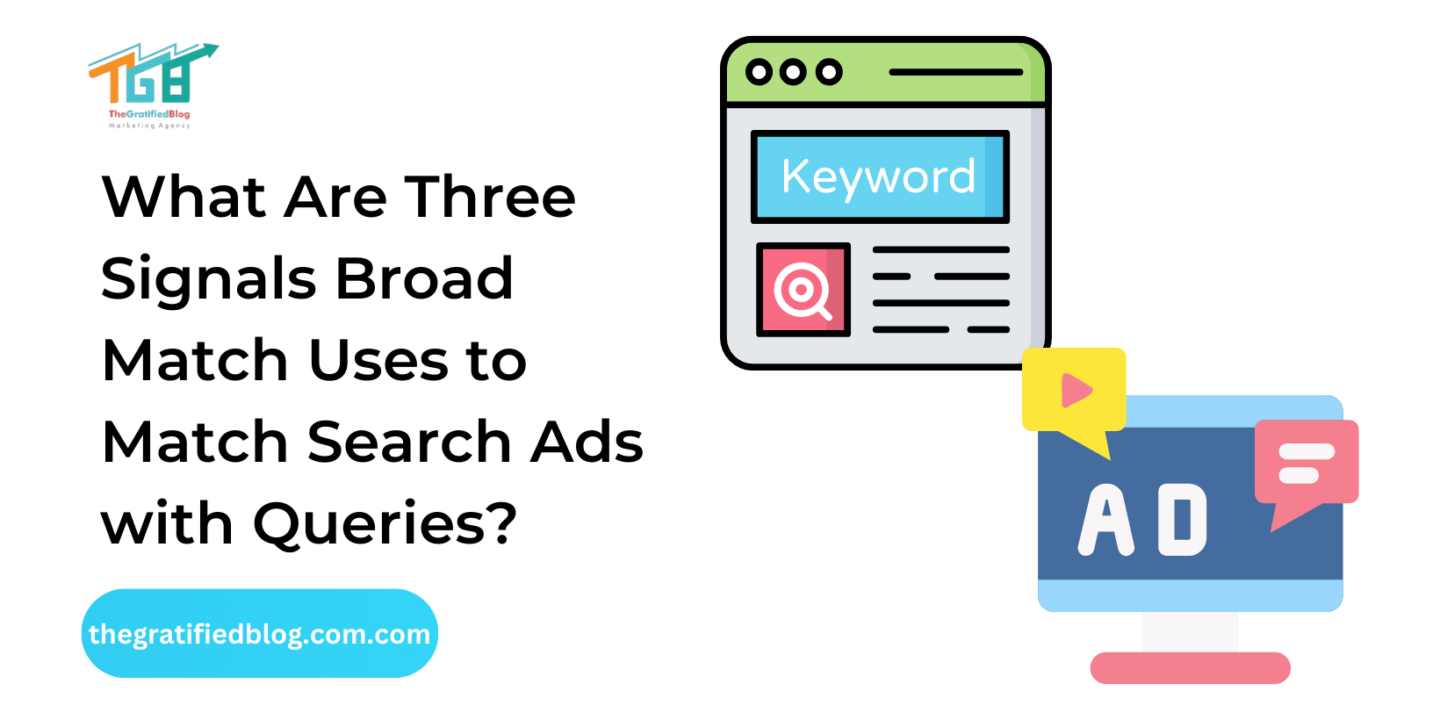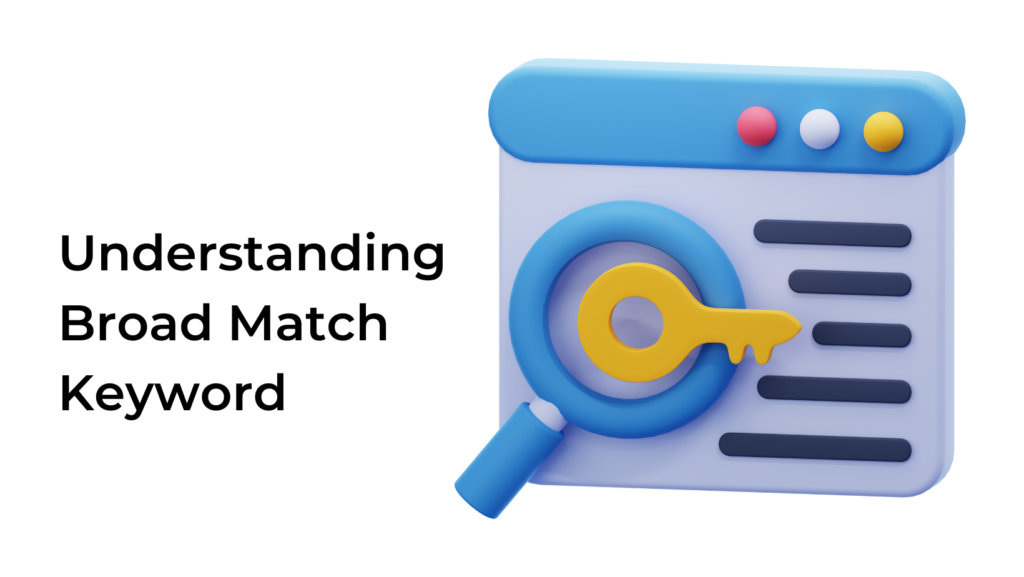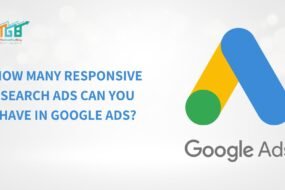
Broad match is one of the most flexible keyword matching options in search advertising. It allows your ads to appear for a wide range of search queries, even those that are not exact matches to your chosen keywords. But how does it work? How does broad match know when to show your ads? The answer lies in the signals it uses to determine relevance.
In this blog, “What are three signals broad match uses to match search ads with queries?” we will explore the three primary signals broad match uses to match your search ads with queries. We will break it down into simple terms, so anyone can understand. Let’s dive in.
Understanding Broad Match in Simple Terms

Broad match is a keyword match type in Google Ads that helps reach a wide audience. It allows your ad to appear when users search for variations of your target keyword. This can include synonyms, related searches, or even user intent.
Key Points:
- Maximized Reach: Broad match casts a wide net, displaying ads to a larger audience. It’s ideal for exploring new markets or identifying untapped opportunities.
- Keyword Variations: Ads show for related terms, such as misspellings, synonyms, or similar phrases. For example, a keyword like “running shoes” might trigger searches for “jogging sneakers.”
- Improved Performance: When combined with Smart Bidding, Google leverages machine learning to understand intent and deliver better results.
- Cost-Effectiveness: While broad match offers exposure, it can also lead to irrelevant clicks if not optimized. Regular monitoring is essential.
- Best for Awareness Campaigns: Broad match works well for businesses aiming to build brand awareness or gather search insights.
For Example:
Imagine you are running an ad for “running shoes.” With broad match, your ad could appear not only for “running shoes” but also for related searches like:
- Best jogging sneakers
- Sports shoes for running
- Buy athletic footwear online
The goal is to connect your ads with search queries that might not be exact matches but are still relevant.
Now, let’s move on to the signals that make this possible.
What Are Three Signals Broad Match Uses to Match Search Ads with Queries?
Broad match is a Google Ads keyword matching option that helps match ads to a wide range of user search queries. It uses three primary signals to determine how to pair search ads with relevant queries:
Signal 1: Search Intent
Search intent is all about why someone is searching for something. Broad match tries to figure out the purpose behind a query, not just the exact words used.
How Search Intent Works:
Let’s say your keyword is “cheap hotels.” Broad match will show your ad to users looking for:
- Budget accommodations near me
- Affordable places to stay
- Low-cost lodging options
The system understands that these searches all have a similar goal: finding affordable hotels.
Why Search Intent Matters:
This signal helps ensure your ad appears for people who are interested in what you offer, even if their wording is different. Broad match uses advanced tools to guess what the user truly wants, focusing on the meaning rather than the words.
Signal 2: User Behavior
The second signal is user behavior, which looks at how people search online. This includes their past searches, clicks, and interactions.
What User Behavior Includes:
- Search History: If someone has searched for “gym memberships” and later searches for “fitness classes,” broad match may show them ads for fitness-related services, even if your keyword is “yoga classes.”
- Click Patterns: If a person often clicks on ads for eco-friendly products, broad match might connect them with ads that mention sustainability, even if it’s not part of the query.
- Device Usage: Broad match also considers whether someone is searching on a phone, laptop, or tablet, adjusting results accordingly.
Why User Behavior Is Important:
This signal allows your ads to reach people who have shown interest in your industry, even if their current search is slightly different. It makes the process more personalized and targeted.
Signal 3: Keyword Context
The third signal broad match uses is keyword context. This involves looking at the overall meaning of your keyword and how it relates to the search query.
What Keyword Context Involves:
- Synonyms and Related Words: Broad match identifies similar terms. For example, if your keyword is “car repair,” your ad might show searches like “vehicle maintenance” or “auto servicing.”
- Search Trends: The system keeps track of popular search terms in your industry and matches ads accordingly. For instance, during the holiday season, “gift ideas” could match with “Christmas presents.”
- Local Relevance: If you are targeting “plumbers near me,” the system considers the location of the searcher and matches them with local services.
Why Keyword Context Helps:
This signal ensures your ad appears for queries that align with the bigger picture of your business, even if the exact words don’t match. It broadens your reach while keeping the relevance intact.
How These Signals Work Together
Now that we know the three signals—search intent, user behavior, and keyword context—let’s see how they combine to match ads with queries.
Imagine you are running a campaign for “organic coffee.” A user searches for “healthy drinks to start the day.” Broad match might show your ad because:
- The search intent is related to health and wellness.
- The user has previously searched for eco-friendly or natural products.
- The keyword “organic coffee” fits within the context of “healthy drinks.”
By analyzing multiple signals at once, broad match ensures that your ad reaches the right audience at the right time.
Benefits of Using Broad Match
Broad match might seem risky because of its flexibility, but it has some major advantages when used strategically:
- Increased Reach: Your ads can appear for a wider variety of searches, bringing in more potential customers.
- Discover New Keywords: Broad match helps you uncover search terms you might not have thought of, giving you ideas for future campaigns.
- Cost Efficiency: When combined with smart bidding strategies, broad match can drive conversions at a lower cost.
- Improved Ad Visibility: Broad match ensures your ads are shown for relevant variations of your keywords, maximizing their exposure to a larger audience.
Tips for Using Broad Match Effectively
To make the most of broad match, follow these tips:
- Pair It with Smart Bidding: Automated bidding strategies work well with broad match, as they focus on driving results based on real-time data.
- Use Negative Keywords: Add negative keywords to avoid irrelevant searches. For example, if you sell premium shoes, you can exclude terms like “cheap footwear.”
- Monitor Performance: Keep an eye on the search terms report to see which queries trigger your ads. Adjust your strategy as needed.
- Combine with Audience Targeting: Narrow down who sees your ads by using audience signals like demographics, interests, or in-market segments.
Common Misconceptions About Broad Match
Some advertisers avoid broad match due to misconceptions. Let’s clear a few up:
- Myth: Broad match wastes money by showing ads to the wrong people.
Reality: When used with smart bidding and audience targeting, broad match focuses on relevant users. - Myth: Broad match is too broad to be useful.
Reality: The advanced signals it uses make broad match more precise than ever. - Myth: You lose control over your campaigns with broad match.
Reality: You can still guide broad match by adding negative keywords and refining your targeting.
Frequently Asked Questions
Q1. What Are Three Signals Broad Match Uses to Match Search Ads with Queries?
Ans. Broad Match uses three primary signals: user intent, user behavior, and keyword context. These factors help match ads to queries even if they don’t contain the exact keywords, ensuring wider reach.
Q2. What signals does Broad Match use to match search ads with queries?
Ans. Broad Match relies on user intent, keyword relevance, and historical search behavior to match ads with related queries, expanding visibility beyond exact or phrase matches.
Q3. Which of these three signals does Broad Match use to match search ads with queries?
Ans. The three signals Broad Match uses are user intent, relevance of the keywords, and past search behavior. These signals help target queries aligned with campaign goals.
Q4. What are the 3 types of keyword matching?
Ans. The three types of keyword matching in Google Ads are Broad Match, Phrase Match, and Exact Match. Each offers varying levels of control over which queries trigger ads.
Q5. What are broad match keywords in Google Ads?
Ans. Broad Match keywords trigger ads for searches related to the keyword, including synonyms and variations. They maximize reach by considering intent and contextual relevance.
Final Thoughts
Broad match is a powerful tool when you understand how it works. By leveraging search intent, user behavior, and keyword context, it ensures your ads reach the right people, even when their queries don’t exactly match your keywords.
If you are new to broad match, start small. Test it with a limited budget, monitor your results, and refine your strategy. With a bit of practice, you will see how this flexible option can enhance your campaigns and bring in more customers.
So, are you ready to give broad match a try? It might just be the missing piece in your search advertising strategy.








No Comments